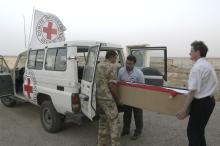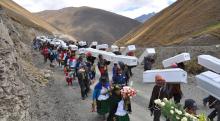Basic international humanitarian law (IHL) rules applicable to this situation:
Arbitrary detention is prohibited.
Persons detained in connection with a non-international armed conflict must be released as soon as the reasons for detaining them cease to exist. Detainees may continue to be held if penal proceedings are pending against them or if they are serving a sentence lawfully imposed.
At the end of hostilities, the authorities in power must endeavour to grant the broadest possible amnesty to persons who have participated in a non-international armed conflict, or those detained in connection with the armed conflict, except for persons suspected of, accused of or sentenced for war crimes.
The case in brief
Between 1976 and 2005, the Free Aceh Movement (‘GAM’), a non-state armed group, fought the government of Indonesia seeking independence for the province of Aceh. Following the Indian Ocean tsunami of 2004, which had a devastating impact on Aceh, both parties demonstrated new readiness to negotiate peace.
In 2005, the parties to the conflict signed a peace agreement bringing hostilities to an end. An Aceh Monitoring Mission (AMM), comprising representatives from the European Union and the Association of Southeast Asian Nations (ASEAN), was established to hold both parties to account.
In accordance with the agreement, the Indonesian government promptly released thousands of people detained during the conflict. This act of compliance with IHL, carried out within the agreed timeframe, built trust between the parties and so contributed to the success of the peace process.
IHL compliance highlights
- On 15 August 2005, the Indonesian government agreed to grant amnesty to all actors involved in GAM activities within 15 days.
- Recognizing the importance of immediately signalling its commitment to the peace process, the Government released a first group of detainees on 17 August 2005.
- On 30 August 2005, the President of Indonesia issued a decree officially granting amnesty to GAM actors, resulting in the release of all remaining detainees.
- The AMM played a valuable supporting role by maintaining pressure on the parties to honour their commitments.
Case prepared by Laszlo Aust and June Goens, LL.M. students at Leiden University, under the supervision of Professor Robert Heinsch, as well as Ashley Peltier with contributions from Alla Ershova (Senior Researchers), and Emma Persson, James Patrick Sexton, and Eliza Walsh (Junior Supervisors), Kalshoven-Gieskes Forum, Leiden University.
A. INDONESIA AND THE FREE ACEH MOVEMENT (GAM) SIGN PEACE AGREEMENT
[Source: ‘Memorandum of Understanding between the Government of the Republic of Indonesia and the Free Aceh Movement’, 15 August 2005, available at http://acehpeaceprocess.net/pdf/mou_final.pdf, accessed on 22 June 2021]
The Government of Indonesia (GoI) and the Free Aceh Movement (GAM) confirm their commitment to a peaceful, comprehensive and sustainable solution to the conflict in Aceh with dignity for all. [...]
The parties are deeply convinced that only the peaceful settlement of the conflict will enable the rebuilding of Aceh after the tsunami disaster on 26 December 2004 to progress and succeed.
The parties to the conflict commit themselves to building mutual confidence and trust.
This Memorandum of Understanding (MoU) details the agreement and the principles that will guide the transformation process.
To this end the GoI and GAM have agreed on the following: [...]
3.1.1 GoI will, in accordance with constitutional procedures, grant amnesty to all persons who have participated in GAM activities as soon as possible and not later than within 15 days of the signature of this MoU.
3.1.2 Political prisoners and detainees held due to the conflict will be released unconditionally as soon as possible and not later than within 15 days of the signature of this MoU. [...]
5.1 An Aceh Monitoring Mission (AMM) will be established by the European Union and ASEAN [the Association of Southeast Asian Nations] contributing countries with the mandate to monitor the implementation of the commitments taken by the parties in this Memorandum of Understanding. [...]
B. INDONESIA RELEASES DETAINED PERSONS
[Source: Kirsten E. Schulze, ‘Mission Not So Impossible: The Aceh Monitoring Mission and Lessons learned for the EU’, International Policy Analysis, July 2007, p. 6, available at https://library.fes.de/pdf-files/id/04786.pdf]
[...] Since the signing of the MOU [Memorandum of Understanding] some 2,000 GAM prisoners were released. In order to build GAM’s confidence in the peace process the amnesty had to be implemented early and quickly. The AMM’s [Aceh Monitoring Mission] key function was to monitor the releases and ‘keep up the pressure’ on Jakarta to ensure that the amnesties were carried out speedily and completely. With respect to speediness the AMM was very successful. Indeed, the first round of releases, 298 persons, came only two days into the agreement on 17 August to celebrate Indonesia’s Independence Day and before the official amnesty was granted through presidential decree 22/2005 on 30 August. Following the decree on 31 August another 1,424 were released. [...]
C. INDONESIA’S RELEASE OF DETAINED PERSONS STRENGTHENS THE PEACE PROCESS
[Source: Nancy-Amelia Collins, ‘Indonesia Releases Aceh Rebels Under Peace Deal Amnesty’, VOA News, Archived on 30 October 2009, available at https://www.voanews.com/a/a-13-2005-08-31-voa15/295490.html]
[...] GAM spokesman, Bahtiar Abdulah, says the releases show the government is sticking to the deal, which stipulates all political prisoners must be released 15-days after the signing of the agreement.
"This is the first step to a bigger process of building trust, because by releasing these people they have already started to implement the whole part of the process," he said. [...]
Daniel Sparingga, a political analyst with Airlangga University in Jakarta says the releases are vital to the success of the peace process.
"I think the government is trying to get the schedule on track," he said. "They believe that the commitment to follow the protocol agreement is very crucial and very important." [...]
[Source: Hamid Awaluddin, “Why is peace in Aceh successful?” in Aguswandi and Judith Large (eds.), ‘Reconfiguring politics: the Indonesia – Aceh peace process’, Accord, Issue 20, 2008, pp. 25-27, available at https://rc-services-assets.s3.eu-west-1.amazonaws.com/s3fs-public/Reconfiguring_politics_the_Indonesia_Aceh_peace_process_Accord_Issue_20.pdf]
[…] There are several reasons why peace in Aceh has been achieveable. First, the government entered the peace negotiations with clear action plans and reasonable offers. It started with the offer of amnesty to GAM, allowing all their prisoners and detainees to be released two weeks after the signing of the peace accord. All the legal charges against the GAM’s activists would be dropped and those who lived overseas could return home unconditionally. The government held about 2700 prisoners and detainees. They are now free.
Along with this, the government offered concrete economic programmes. The Acehnese government was to be allowed to keep 70 per cent of Aceh’s revenues. These revenues can undoubtedly propel the economy forward, which was ruined during the war. Such a high percentage of revenues was an unimaginable hope during the war. In short, the unfairness of the previous share of revenues led to three decades of bloody conflict. This is now over. Aceh is developing a better economy now. […]
The tsunami that devastated Aceh and caused the loss of almost 200,000 human lives became another factor that led to a successful outcome. The tsunami created common ground which allowed the Indonesian government and GAM to start peace negotiations. Both sides felt pity for all those who were suffering. Both sides realized that helping the victims of the tsunami was much more important than continuing the conflict. Besides, the international community was in Aceh for humanitarian purposes, so both sides were reluctant to keep fighting. Sadness seemed to bury the will to fight. […]
Discussion
I. Classification and Applicable Law
1) How would you classify the situation between Indonesia and GAM prior to the 2005 peace agreement? What additional information would you need to make such a determination? (GC I-IV, Art. 2, Art. 3; P I, Art. 1; P II, Art. 1)
II. Obligations regarding the Release of Detainees
2) What is the difference between detained persons in non-international armed conflicts and prisoners of war in international armed conflicts? (GC I-IV, Art. 3; GC III, Art. 4; CIHL, Rule 99, Rule 106, Rule 128)
3) When are parties to a non-international armed conflict required to release detained persons? Is an agreement between the parties, such as the Memorandum of Understanding between Indonesia and GAM, a prerequisite for the release? (GC I-IV, Art. 3; CIHL, Rule 128)
4) Is there an obligation to grant amnesty before releasing detained persons who have participated in a non-international armed conflict? What are the main reasons amnesty might be encouraged in non-international armed conflicts? Can amnesty be granted to anyone who participated in a non-international armed conflict? What are the exceptions? (CIHL, Rule 159)
III. Elements Contributing to Respect for IHL
5) (Document A, Document C, Source 2) How has the 2004 Indian Ocean tsunami influenced the decision of Indonesia and GAM to conclude a peace agreement prompting the release of detainees? In your opinion, why might a large-scale natural disaster compel parties to comply with IHL?
6. (Document C, Source 1) GAM spokesperson, Bahtiar Abdulah, stated, “[t]his is the first step to a bigger process of building trust, because by releasing these people they have already started to implement the whole part of the process.” To what extent do you think the release of detainees can help build trust between parties to an armed conflict?
7) (Document B) “The first round of releases […] came only two days into the agreement on 17 August to celebrate Indonesia’s Independence Day.” Do you think the timing of a national holiday influenced the release of detainees? If so, why? What is it about public celebration that might motivate actors to comply with IHL?
8) In your opinion, how might amnesty coupled with release contribute to a transition to peace after an armed conflict? Do you think the transition to peace was a motivation for Indonesia to grant amnesty?
9) (Document B) The role of the AMM’s [Aceh Monitoring Mission], comprising EU and ASEAN countries, was “to monitor the implementation of the peace process, notably by ensuring that releases and amnesties were carried out speedily and completely.” To what extent do you think the presence of third parties can influence actors to comply with IHL?






